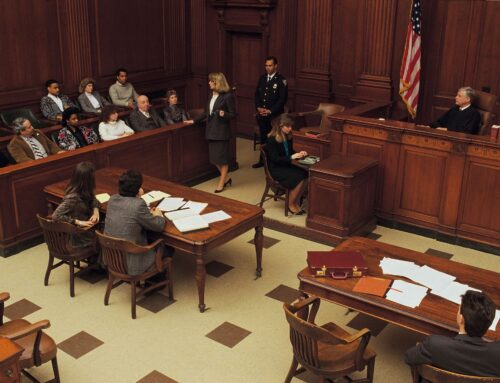The wheels of justice can turn slowly … or sometimes very, very slowly. However, when you are injured in a car accident, you want those wheels to turn as fast as possible because you are without a car, incurring medical bills, and possibly missing work because of someone else’s negligence. So just how long will it take to get your life back and your case settled? As with most things in the legal world, the ultimate answer is “it depends.”
Taking Your Personal Injury Case to Trial
Negotiation
It’s helpful to review a typical personal injury case to get a better idea of a timeline. First, do your due diligence and find a car accident attorney who’s qualified, competent, knowledgeable, and has a record of winning personal injury cases similar to yours. Barring unforeseen circumstances, the first thing your attorney will most likely do is negotiate with the other driver’s insurance company. This step, if successful, can save you a lot of time, money and resources. If the driver is not insured, your attorney will then attempt to negotiate with their attorney, if they are represented. Your attorney will send out a settlement demand with the figure of what you would accept as compensation for your injuries and damages. More likely than not this is an opening salvo, particularly when an insurance company is on the other side. The parties will negotiate back and forth and may reach a settlement. If the parties are so far apart that no agreement can be reached, your attorney will file a lawsuit.
File a Lawsuit
The next step is that your attorney will file a lawsuit on your behalf (you’re the plaintiff in this case) against the other driver and their insurer, if they have one (they’re the defendants). Once the lawsuit is filed, the other parties must be served. This means that they must be given formal notice by the court that a lawsuit has been filed against them. If service is not made, the lawsuit cannot proceed because the parties will be deemed to not know of the lawsuit.
The other side typically has 30 days from the date they are served with the lawsuit to file a response. In the response, they can deny or agree with the allegations. If you have reached the point where a lawsuit is necessary to achieve any kind of resolution, chances are the defendants will deny all allegations and the process will continue. They may also add a counterclaim seeking damages against you as the other driver at this point.
Discovery
After the response has been filed, the lawsuit enters one of the most important phases: discovery. In discovery, your attorney will ask for documents, statements, and information from the other side related to the car accident and anything else that may be relevant to the issues of liability. The other driver’s attorney will ask the same from you. All parties and witnesses will be deposed meaning they will be questioned under oath by both sides’ attorneys about the accident. There may also be expert witnesses involved such as accident reconstruction specialists or medical experts who will be deposed to give their expert opinions.
The discovery phase of the litigation can take months depending on the number of documents involved, the number of witnesses to be deposed, whether experts are involved and need to review documents or conduct reconstructions, and of course, everyone’s availability. The fewer parties, witnesses, and complexities involved, the less time the discovery phase will last.
One of the reasons the discovery phase is so critical is that, many times, a lawsuit can be settled without going to trial based on what is disclosed in discovery. If it is so damaging to the other side that it would be impossible for them to win at trial, settlement negotiations will likely re-start and the parties may reach an agreement.
Trial
If after discovery, the parties have not reached a settlement, the case will go to trial. A trial must be scheduled well in advance as the courts are very busy. If a jury is required, this may further delay things since the court will need to summon a jury pool and there will need to be jury selection. This is not an issue if your attorney elects to have a bench trial, which is a trial where the judge acts concurrently as judge and juror. The judge, in this instance, issues the verdict.
Depending on the complexity, a trial can take several days to a week or more. Of course, the more complex the case, the more likely it will take more time. Jury deliberations will add additional time. There may be numerous questions for jurors to answer in order to reach a verdict.
All told, then, how much time does this process take? Easily months and possibly years, again depending on the complexity of your case. However, on average, most personal injury cases take several months to wrap up in court.
Other Factors that Will Influence a Personal Injury Case Timeline
It is important to consider other factors that could affect how long your case takes to resolve. One factor is whether or not the other side is alleging that your driving or behavior contributed to the accident or if they deny liability for the accident at all. This adds one more complex layer of investigation to the case that has to be resolved before an agreement or verdict can be reached. Another factor is the severity of your injuries and if you are permanently disabled by the accident. This means that the stakes are higher and the damages that your attorney are seeking are very high.
What if your injuries from the accident don’t show up right away? Or what if you initially decided not to file a lawsuit but then changed your mind? Look to California’s statute of limitations which are rules about how long you have to file a lawsuit. If the other party is a person or a private company, the law gives you two years from the date of the injury to file suit. If the other party is a public entity such as a city or county, you have six months to file a claim – not a lawsuit – and if that is rejected, you have another six months to file the lawsuit.
In case you ever suffer a personal injury, hire a lawyer to represent you, and then you must decide between a settlement vs court trial. As you do, consider these statistics from the Law Dictionary:
- Only about 5% of personal injury cases in the US ever go to trial
- Just over 95% of personal injury cases get settled before the trial, i.e., money needed quickly, cost-benefit of going to trial not worthwhile, seeking arbitration perhaps a more efficient and less costly option.
- This one is highly intriguing: about 90% of personal injury cases that do go to trial come out on the losing end
- If you decide that you want a court trial and are deciding between a trial judge or jury, opt for the trial judge. You apparently have a better chance of winning and a better chance of being awarded compensatory damages more to your liking.
If at all possible, give time a chance to sharpen perspective and reality. Sometimes, injuries take more time to reveal themselves. If you rush into a settlement and find out later that your injuries are worse than you thought, you will be out of luck.
We tend to state this a lot in our articles and the only reason we keep on repeating this mantra is because it’s so true: the most important first step after a car accident is to get yourself a really competent and experienced car accident attorney. If you’ve been in a truck, bike, motorcycle, pedestrian, or Uber/Lyft accident, find an attorney who has experience and has shown positive results with those types of accidents. If you don’t, it could cost you big time in the long run – financially and physically.






